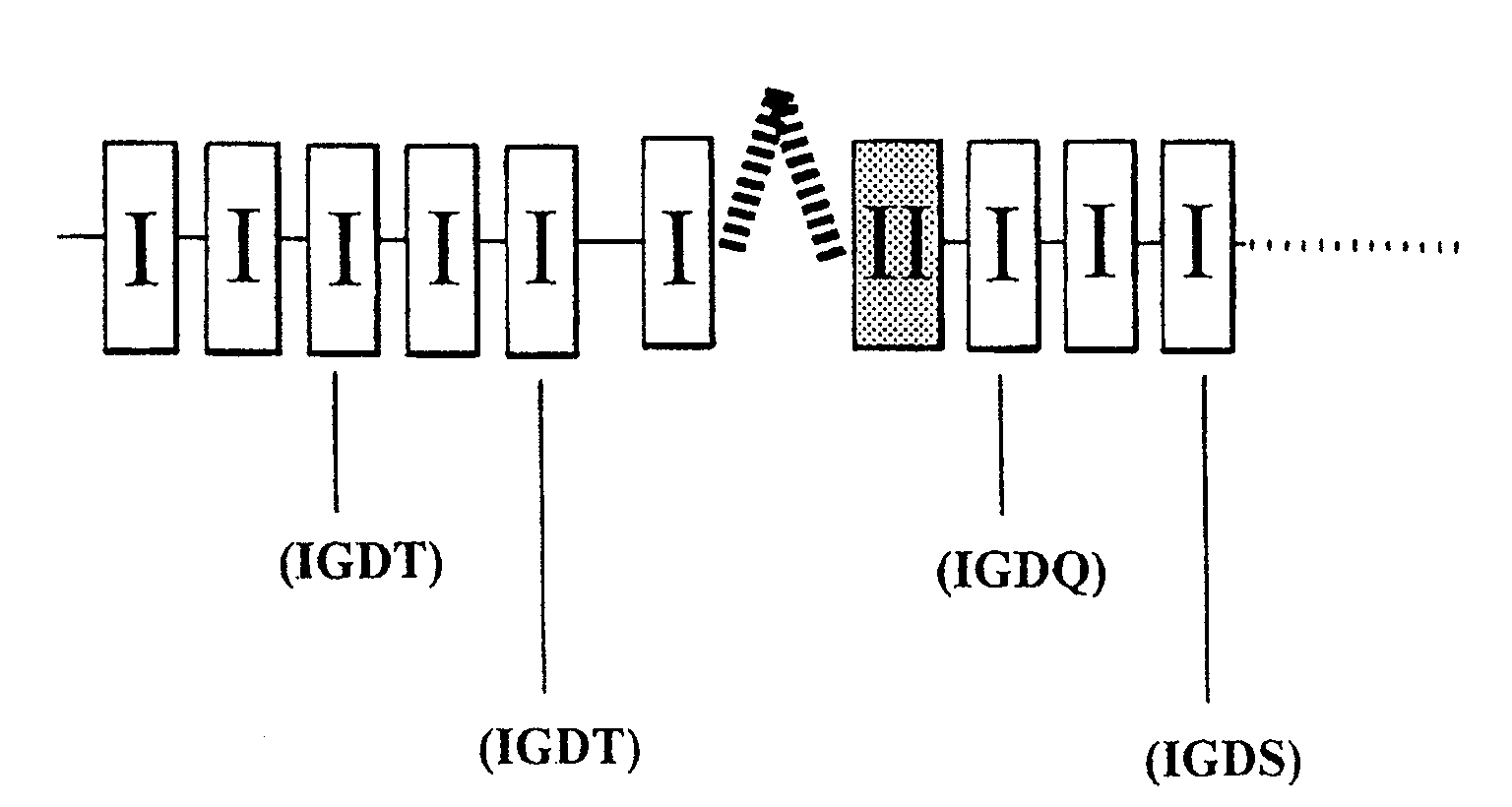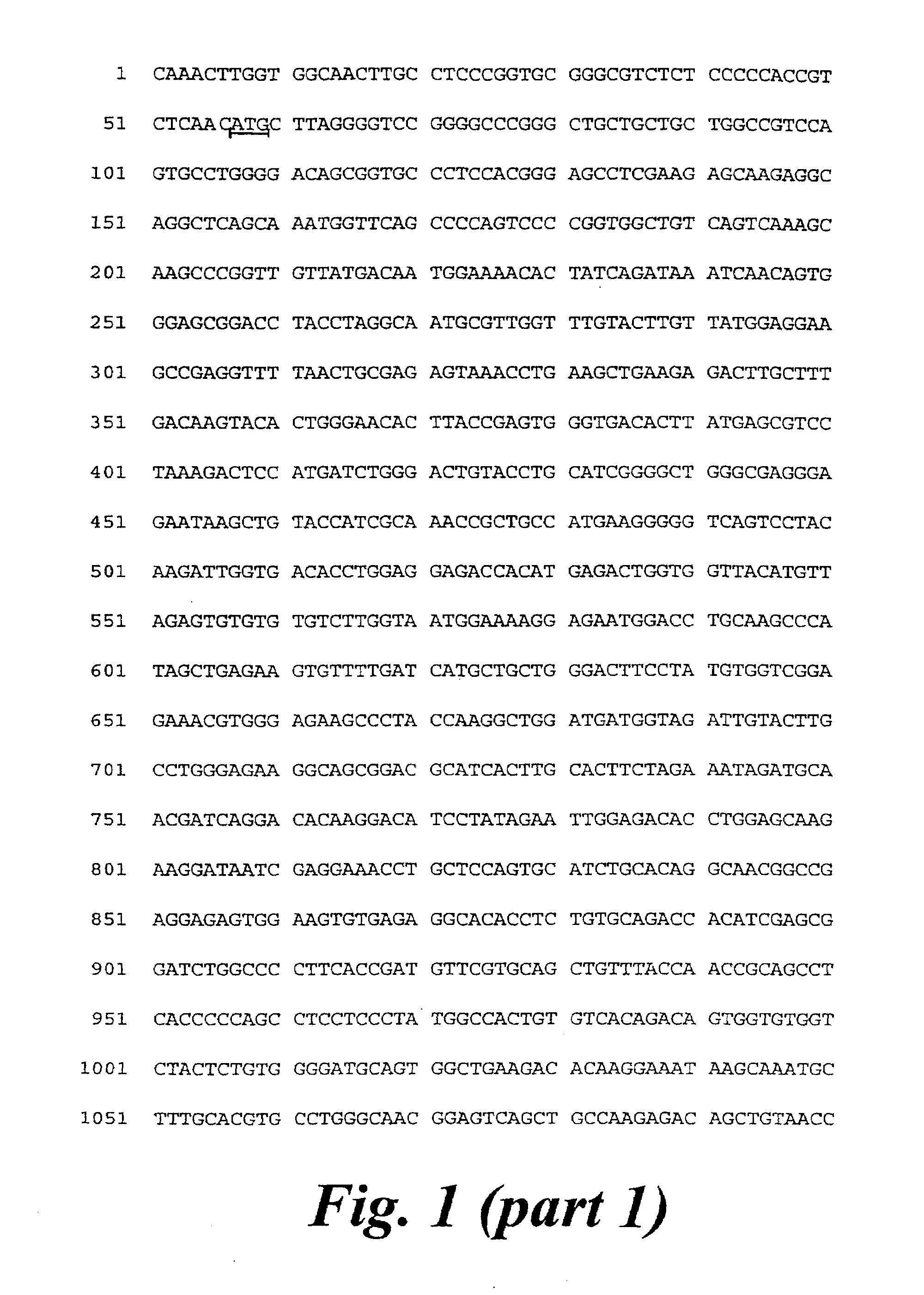Polypeptides, polynucleotides and uses thereof
a technology of polynucleotide and polypeptide, applied in the field of polypeptides and polynucleotides, can solve the problems of previously unavailable methods of measuring, identifying and localizing msf, and achieve the effect of preventing the formation of msf, and improving the quality of li
- Summary
- Abstract
- Description
- Claims
- Application Information
AI Technical Summary
Benefits of technology
Problems solved by technology
Method used
Image
Examples
example 1
Cloning and Sequence Analysis of pMSF1I, a Clone Encoding MSF
[0147]A cDNA library was constructed using mRNA extracted from a human foetal fibroblast cell line, MRC5-SV2, in the vector λZapII.
[0148]A primer based on peptide sequence from the gelatin-binding domain (GBD) of fibronectin was used together with a vector primer in the polymerase chain reaction (PCR) to amplify a fragment of 1.2 kb. Sequence analysis showed a strong homology to GBD for most of the fragment. Clear differences included an internal deletion of 45 bp, and a 3′ unique sequence of 175 bp.
[0149]The 3′ unique sequence was used as a probe for screening the library, using the digoxigenin-labelled system. Positive plaques were picked for further analysis by secondary and tertiary screening, followed by in vivo excision of the pBluescript™ phagemid containing the cloned insert.
[0150]A plasmid containing an insert of 2.1 kb, named pMSF1I, was sequenced by the Sanger-dideoxy method, using a progressive priming approach...
example 2
Demonstration of the Presence of MSF-Secreting Fibroblasts in Sections of Breast Cancer, but not Normal Breast Tissue
[0155]In situ hybridization using a riboprobe based on the unique coding region for the unique C-terminus of MSF demonstrates the presence of MSF-secreting fibroblasts in sections of breast cancer, but not normal breast tissue.
[0156]Suitable riboprobes contain the entire unique nucleotide sequence of MSF-1I (position 1953-2147), and may include up to 10 bases upstream and contained within the fibronectin sequence (position 1943-2152). This ensures high specificity towards MSF-1I, whilst allowing the use of a probe of longer length. A digoxigenin-labelled riboprobe containing a major portion of the unique sequence (position 1974-2147) is used. This region was selected on the basis of the position of convenient restriction sites.
example 3
Monoclonal Antibodies Which are Specific to MSF and do not Cross-React with Fibronectin
[0157]Monoclonal antibodies are raised using any of the currently available standard procedures. The immunogen is a synthetic peptide based on the 10 amino acid unique tail of MSF (VSIPPRNLGY, SEQ ID NO: 41) or is based on the peptide sequences:
ISKYILRWRPVSIPPRNLGY;(SEQ ID NO: 5)orQQWERTYLGNALVCTCYGGSR;(SEQ ID NO: 6)orPCVLPFTYNDRTDSTTSNYEQDQ;(SEQ ID NO: 7)orTDHTVLVQTRGGNSNGALCH;(SEQ ID NO: 8)orVGNGRGEWTCIAYSQLRDQCI(SEQ ID NO: 9)
PUM
| Property | Measurement | Unit |
|---|---|---|
| apparent molecular weight | aaaaa | aaaaa |
| apparent molecular weight | aaaaa | aaaaa |
| apparent molecular weight | aaaaa | aaaaa |
Abstract
Description
Claims
Application Information
 Login to View More
Login to View More - R&D
- Intellectual Property
- Life Sciences
- Materials
- Tech Scout
- Unparalleled Data Quality
- Higher Quality Content
- 60% Fewer Hallucinations
Browse by: Latest US Patents, China's latest patents, Technical Efficacy Thesaurus, Application Domain, Technology Topic, Popular Technical Reports.
© 2025 PatSnap. All rights reserved.Legal|Privacy policy|Modern Slavery Act Transparency Statement|Sitemap|About US| Contact US: help@patsnap.com



